This review page is supported in part by the sponsors whose ad banners are displayed below |
 |
Looking at Hugues's €200.000 Venetian violin, I asked him how he'd allocate his percentage of any winnings from first sales of the Grande Castine. "I'd pay down what I owe on my instrument so I can get a better one." Damn, some folks really do have their priorities sorted.
|
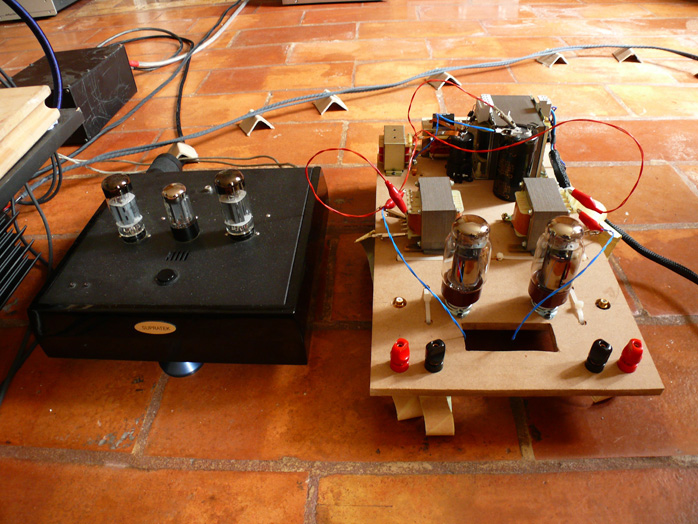 |
|
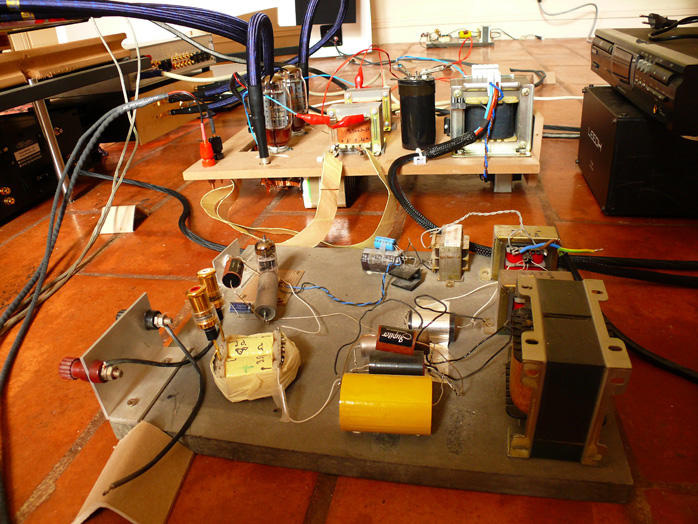 |
The Grande Castine is expected to retail at €49.995/pr without infraplanar subs. The three horny musketeers below have just contracted with their infraplanar colleagues for larger 80 x 80cm bass panels exclusive to them. Those will mount in their own custom metal frames to control and adapt cosmetics to the GC horns. (The present commercial Infraplanar seems marketed primarily at DIYers and prospective licensees like AudioNec and is cosmetically quite bare-boned especially in the back). The final Grande Castine bass package will include a pair of sub panels, Hypex sub amps and a custom active analog crossover.
|
 |
Having heard big Avantgarde, Acapella and Cessaro horn setups at various shows with the invariably compromised results this entails, I was really most impressed by what I heard in the French Cognac area after we'd improved the original setup. The speakers did low levels exceptionally well as you'd expect from such a design. They also retrieved cubits of ambient data when recorded and imaged to size rather than blow up solo lutes to church organ dimensions. These big speakers could play very small when needed. Naturally, any serious assessment would need to spend days if not weeks on positioning to insure the speakers play the room to the highest degree. After changing the toe-in of the horns, moving the listening seats, relocating the subs behind the seat and altering their low-pass frequency and attenuation slope, all initial issues were solved so dramatically that nobody present felt compelled to spend the remaining time futzing rather than simply listen through the various electronics options including Neodio's top one-box CD player and matching integrated (Jean-Marie's own source was a 6-year old dCS player).
|
|
|
Knowing neither the components nor room except for the J2, my personal walk-away impressions were of astonishing linearity, very high but unforced resolution, stupendous LF extension and particularly articulation all the way down even at low levels. I didn't hear any beaming issues where certain bands would focus harder and slicier than others, often a concern. Transitions from driver to driver were undetectable. If the shadowing of the tweeter by the physical horns above and below had any effects, I'd have to hear a different alignment geometry to know. My only criticism vis-à-vis my own resonator-enhanced home reference actually was the very top end. Relative to the exceptionally even and articulate bass and very punchy, visceral midbass and immediate vocal band, the treble lacked some amplitude on its very top. Triangle decays and such faded prematurely. Marco agreed and already had an idea to improve this aspect.
|
 |
As a classical musician with absolute pitch and symphonic as well as chamber-music experience, Hugues Borsarello isn't merely very keyed in to response linearity (to within 5-or-so cycles, he can pick out precise hot spots or dips by frequency). He is adamant that the 100 - 300Hz window is the most critical for musical playback realism. It's what Marco spent the most time to optimize with his rectangular horn, applying Le Cleach formulae to the geometric variables of horn length, flare, throat and mouth diameter and going through prototype after prototype. He believes truncated horns to be problematic and that each frequency band covered by a 3-way horn must use specific minimum horn diameters. The above photo shows how both his spherical horn curvatures progress to full vertical lips.
|
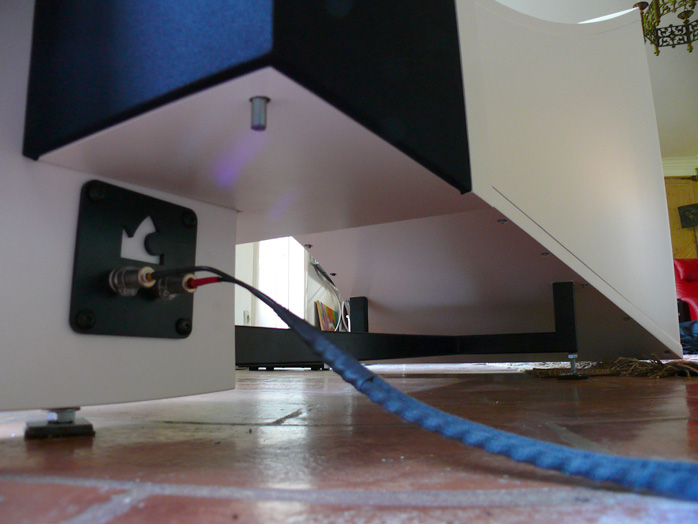 |
"I met Jean-Michel at the Paris show September 2006. Once JM heard my concrete horns, our collaboration for this all-out project began right afterwards. Hugues helped me to voice the system, Jean-Michel's commercial experience and funding were instrumental in the final cosmetics and completion of the project. Aside from certain Italian and Spanish driver parts and a few US resistors, the Grande Castine is a truly Gallic project. We are very lucky to have Cyrille Pinton on board whose work on the final 15" woofer was vital to the results you heard. With Great Plains' Altec reissue not up to our standards, we were hard pressed to find the right driver for our application. Cyrille's comprehensive rebuild of a commercial platform made all the difference**.
|
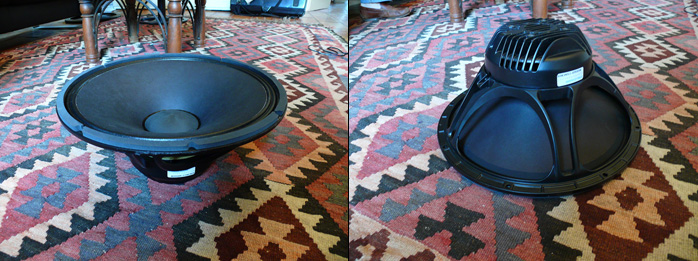 |
"Acknowledgements from my end also must go to my wife who lived with me through 12 years of mostly solitary, completely obsessive work on mastering horn design. Instead of fixing plumbing problems in our house, I'd pour over and myself and concrete into horns. She kept encouraging me whenever I'd pursued another dead end to feel like quitting. She hasn't yet heard what you just experienced. She really deserves to know that her perseverance and sacrifices paid off in the end."
________________________________
**
Cyrille Pinton: "The 28g paper cone is custom-made for us, the ultra-high compliance cloth surround is a special very small double-roll design. The goal was max radiating surface of 908cm² with low Fs and linear excursion within a small ±1.5mm Xmax on an underhung edge-wound ribbon voice coil of 6 grams. This parameter is always a trade-off between linearity and SPL but since horn loading gives us high output from low excursions, our focus was linearity. In the final driver version, we worked on small improvements to increase Xmax to ±2mm and bump up sensitivity a touch. The motor is a Neodymium construction with 1.3T magnetic flux density in the gap."
|
|
|
Jean-Michel's rave den for the kids, above Marie's metal-cutting and welding space, housed the original Grand Castine version introduced on the previous page.
|
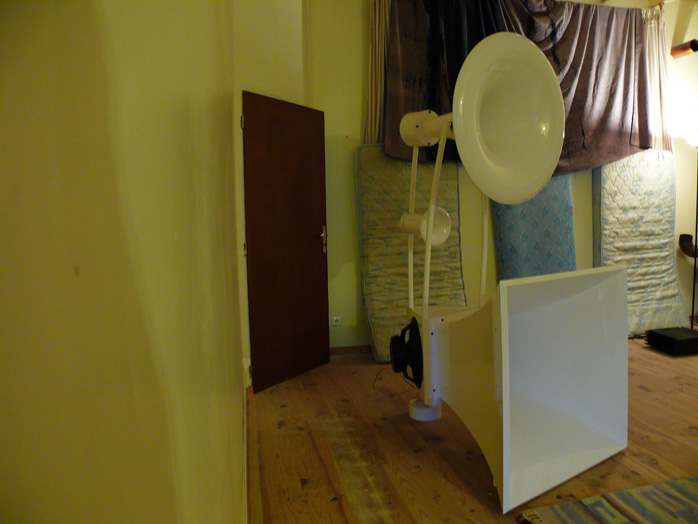 |
Cosmetically and structurally, the revised version is more sound. Sonically, I didn't hear these on the pair of FirstWatt F4 amps they were set up with. I take the designers' word for it that the new version also performs considerably better.
|
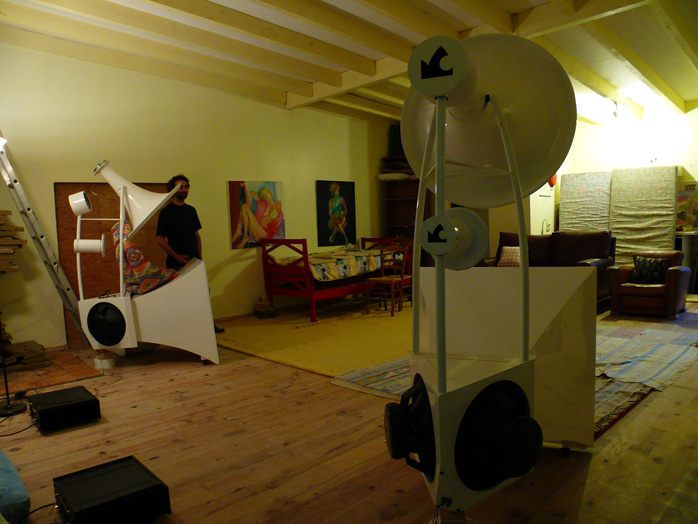 |
Conclusion: I'm no expert on horns. I'm just a prior owner and admirer. The Grande Castine is too physically imposing for the kind of space I currently inhabit or am likely to in the future. But never mind that. My visit wasn't a shopping spree in disguise. It was to spotlight an exciting new product. This expertly voiced 3-way horn system with implausible planar subwoofers now factors in the top two presentations of its kind I've encountered (the other was an Avantgarde Acoustic Trio setup with BAT at a San Francisco Stereophile Show).
|
 |
As you can see in the pictures, the room had no acoustic treatments at all, the only diffusor being the bottle of 1996 Sauternes Grand Cru, the only absorber the terrine of duck Foie Gras. Where I believe the Grande Castine goes beyond successful peers and precursors is in its integration and frequency extension of the planar bass system. (Hugues thinks it could be mounted to the ceiling above the listening seat on short stand-offs, merely requiring a slight adjustable delay in his discrete crossover.) To avoid unsightly bass horns of overkill dimensions, some horn devotees resort to tower-of-power line-source woofers. I suspect that the infraplanar solution invokes rather less room integration issues and textural discontinuity. Let's face it, dynamic subwoofers can be a royal pain in the arse, particularly when they must match the speed and precision of high-efficiency horn systems. Ease vs. effort. Yet living without a proper infrasonic foundation once you've heard a good one becomes unacceptable. The Grande Castine's is more than just good. It's a potential breakthrough.
What does it all add up to? In a form factor still fit for an admittedly upscale-ish normal home, our three frogs—with help from a forth one on proprietary driver modifications—have managed to combine the often mutually exclusive. They've authored a true full-range horn speaker with simplicity and elegance. By comparison, the Cessaro horns are cosmetically challenged, their and Avantgarde's bass solutions brute force efforts. Another sonic advantage for the French is their big but deliberately bandwidth-limited upper bass horn with its dipole 15" woofer. It delivers the necessary transient impact which smaller horns seemingly do not (at least my Duos never did).
|
 |
The notion of concrete horns conjures up thick-walled behemoths. Marco Henry's are lithe and thin yet address resonance and deformation issues which thin ABS versions do not. Thick turned wood à la Cessaro meanwhile looks unsightly and massive. The narrow but strong wood-formed spine of the Grande Castine is functional, elegant and locks in proper time alignment. The matte white overall décor is iPod hip. After 12 long years, Marco's wife has real reason to be proud. Perhaps Hugues will even get his new violin. Anyone serious about serious production horns must investigate the Grande Castine. Despite a name that's not exactly intuitive, it's a real contender. Bottoms up to the commercial success its makers deserve. It certainly was a pleasure and privilege to hear their effort in a suitably large space. Even visiting director of Neodio brand Stephane Even who turned heads in Las Vegas when showing his CD player with Wilson and Lamm was impressed. Looking askance at the infra sub, he shook his head. Then he sat back down, listened some more, grinned and pronounced proudly "Vive la France!" Cheers. |
|
|
 |
Jean-Michel Maumont's email
|
[jm.maumont16@gmail.com] |
|
 |